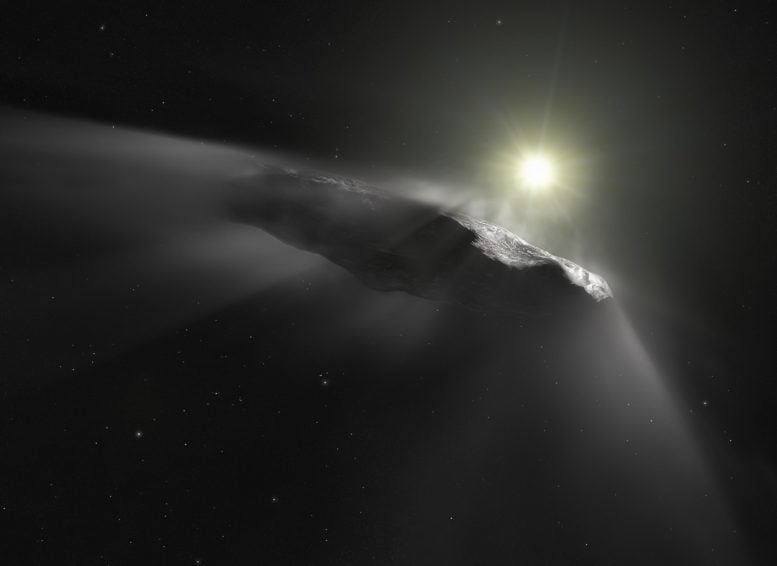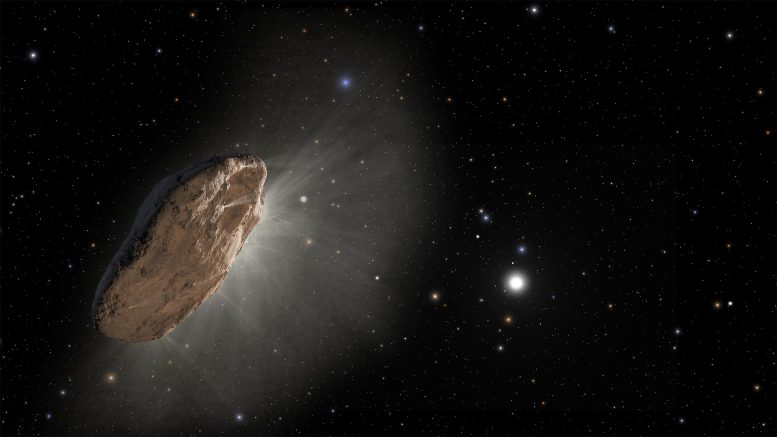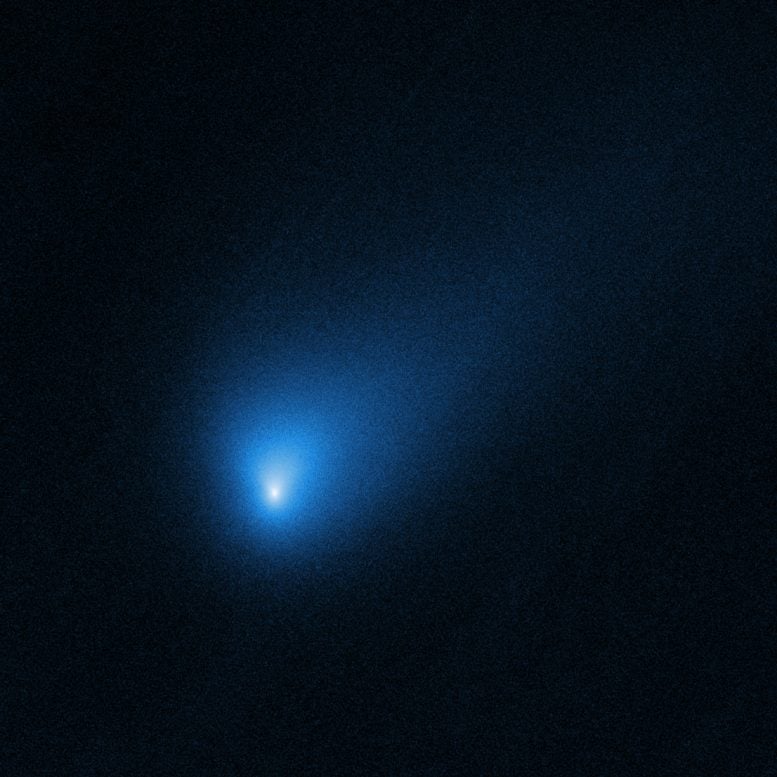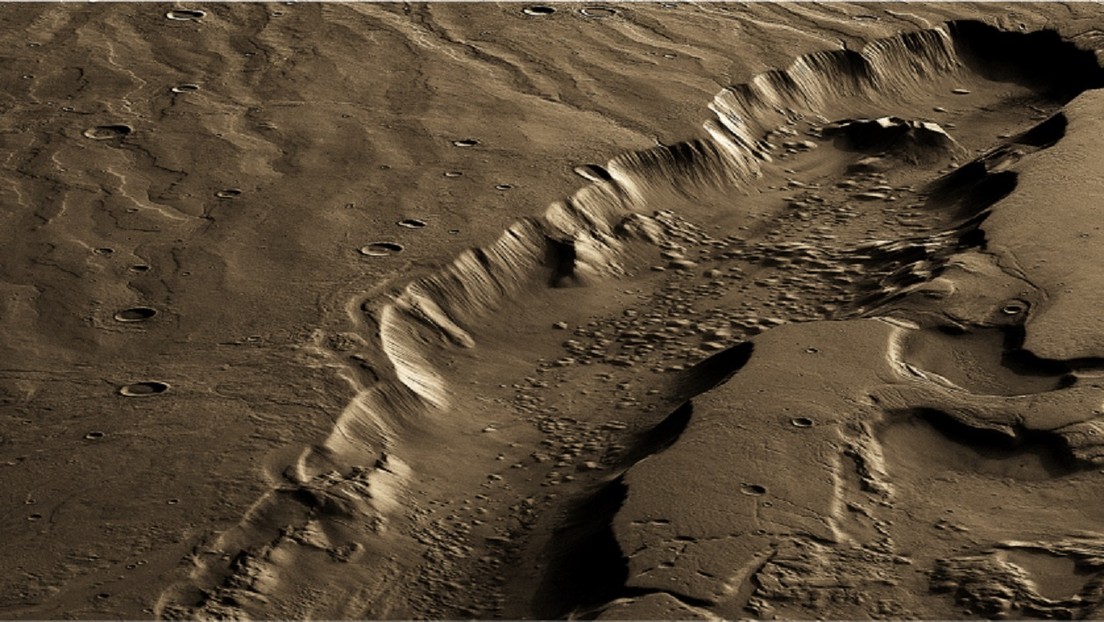Los astronautas de la NASA llegan para el primer vuelo espacial tripulado de Boeing
Horoscopo
Oportunidad sin precedentes para investigar al próximo visitante interestelar con el Telescopio Espacial Webb

La impresión de este artista muestra el primer objeto interestelar descubierto en el sistema solar, `Oumuamua. Crédito: ESA/Hubble, NASA, ESO, M. Kornmesser
Los científicos descubrirán los objetos que se entrometen en nuestro territorio cósmico
Hasta ahora, solo se han visto dos objetos interestelares zumbando en nuestro sistema solar, pero los científicos creen que hay muchos más al acecho. Cuando se descubre el siguiente,[{» attribute=»»>NASA’s powerful new James Webb Space Telescope may have a ringside seat for analyzing this interloper. Webb will help astronomers learn about its composition, formation history, and home system. For the first time, scientists will get an up-close-and-personal view of something born outside our solar system.

This artist’s illustration shows the first identified interstellar visitor, 1I/’Oumuamua, discovered in 2017. The wayward object swung within 24 million miles of the Sun before racing out of the solar system. ‘Oumuamua still defies any simple categorization. It did not behave like a comet, and it had a variety of unusual characteristics. As the complex rotation of the object made it difficult to determine the exact shape, there are many models of what it could look like. Credit: NASA, ESA, Joseph Olmsted (STScI), Frank Summers (STScI)
One of the most exciting findings in planetary science in recent years is the discovery of interstellar objects passing through our solar system. So far, astronomers have confirmed only two of these interlopers from other star systems — 1I/’Oumuamua in 2017 and 2I/Borisov in 2018 — but many, many more are thought to exist. Scientists have had only limited ability to study these objects once discovered, but all of that is about to change with NASA’s James Webb Space Telescope.
“The supreme sensitivity and power of Webb now present us with an unprecedented opportunity to investigate the chemical composition of these interstellar objects and find out so much more about their nature: where they come from, how they were made, and what they can tell us about the conditions present in their home systems,” explained Martin Cordiner, principal investigator of a Webb Target of Opportunity program to study the composition of an interstellar object.

This Hubble Space Telescope image of 2I/Borisov shows the first observed rogue comet, a comet from interstellar space that is not gravitationally bound to a star. It was discovered in 2019 and is the second identified interstellar interloper, after ‘Oumuamua. 2I/Borisov looks a lot like the traditional comets found inside our solar system, which sublimate ices, and cast off dust as they are warmed by the Sun. The wandering comet provided invaluable clues to the chemical composition, structure, and dust characteristics of planetary building blocks presumably forged in an alien star system. It’s rapidly moving away from our Sun and will eventually head back into interstellar space, never to return. Credit: NASA, ESA, and D. Jewitt (UCLA)
“The ability to study one of these and find out its composition — to really see material from around another planetary system close up — is truly an amazing thing,” said Cordiner, an astrophysicist at NASA’s Goddard Space Flight Center in Greenbelt, Maryland and The Catholic University of America. The first two interstellar objects detected were very different: One was very comet-like, and one was not. Cordiner and his team hope to find out how unique those objects were and whether they’re representative of the broader population of interstellar objects.
Triggering Process
Astronomers are constantly monitoring various sources of information, ranging from amateur observers to professional observatories, in the hopes of finding the next interstellar interloper. When the next such object is first detected, scientists won’t immediately be certain if it’s an interstellar object. They’ll need additional observations over a period of days, weeks, or even months to confirm it — depending on its brightness.
Once they have confirmation that the object came from outside the solar system based on its “hyperbolic” orbit, and they are certain the object didn’t come from the outer reaches of our own solar system or the Oort cloud, they can calculate the trajectory of the object across the sky. If that trajectory intersects with Webb’s viewing field, Cordiner and his team will make the observations.
The Science
The team will use Webb’s spectroscopic capabilities in both the near-infrared and mid-infrared bands to study two different aspects of the interstellar object. First, using the Near-Infrared Spectrograph (NIRSpec), they will analyze the chemical fingerprints of gases released by the object as any ices that might be present are vaporized by our Sun’s heat. Second, with the Mid-Infrared Instrument (MIRI), they will observe any dust that the object is producing — small, microscopic particles; larger grains; and even pebbles that may be lifted off the surface and surrounding the object.
With its high spectral resolution, NIRSpec can pick out the emission from individual gases, allowing the team to detect specific molecules such as water, methanol, formaldehyde, carbon dioxide, carbon monoxide, and methane. MIRI, in the mid-infrared, is more tuned to the heat spectrum produced by solid particles, such as dust grains or the object’s nucleus.
Powerful New Insights
In our own solar system, comets are icy remnants from the era of planet formation around our Sun, so they can provide unique insight into the chemical conditions present in the earliest history of our solar system. This Webb program has the ability to reveal — for the first time — similarly powerful insights into the chemistry of the formation of planets around other stars.
Astronomers don’t fully understand the exact chemical processes involved in forming planets. For example, how does a planet arise from simple chemical ingredients? Does it happen in the same way around all stars? Was there anything peculiar about the way our own planets formed around our Sun, compared with how they form around other stars elsewhere in the galaxy? If scientists can get proof of the chemical conditions present in other planetary systems by observing an interstellar object and seeing what it’s made of, then they can get a much clearer picture of the true extent of chemistry that’s possible in those other planetary systems.
A New Window with Webb
Interstellar objects have not been observed before in these important near- and mid-infrared wavelength ranges, so the possibilities for new discoveries are quite profound. With trillions and trillions of interstellar objects buzzing around the galaxy, the team doesn’t know what they are going to find, but they know that it will be fascinating.
“With Webb, we can do really interesting science at much fainter magnitudes or brightnesses,” explained teammate Cristina Thomas, an assistant professor of astronomy at Northern Arizona University. “Also, we’ve never been able to observe interstellar objects in this region of the infrared. It opens a lot of opportunities for the different compositional signatures that we’re interested in. That’s going to be a huge boon for us!”
The James Webb Space Telescope is the world’s premier space science observatory. Webb will solve mysteries in our solar system, look beyond to distant worlds around other stars, and probe the mysterious structures and origins of our universe and our place in it. Webb is an international program led by NASA with its partners, ESA (European Space Agency) and the Canadian Space Agency.

Experiencia en periódicos nacionales y periódicos medianos, prensa local, periódicos estudiantiles, revistas especializadas, sitios web y blogs.
Horoscopo
El cuarteto copia el espacio en Clark para convertirse en el Centro de Aprendizaje Judío Jabad de Evanston
En algún momento antes de septiembre, el espacio de 2,300 pies cuadrados en 825 Clark St., anteriormente ocupado por Quartet Copies, probablemente volverá a estar lleno de actividad como el Centro de Aprendizaje Judío Jabad de Evanston.
En una llamada telefónica, el rabino Meir Hecht de Jabad de Evanston confirmó que Jabad compró el espacio a principios de 2024.
Espacio de aprendizaje y biblioteca abiertos al público.
Charles Davidson de Charles Davidson Group presentó la solicitud de análisis de zonificación en línea el 25 de febrero y la solicitud fue aprobada el 11 de marzo.
La solicitud incluía una carta de Hecht, como director de la Fundación de Aprendizaje Judío, que indicaba que el futuro centro de aprendizaje ofrecería clases para adultos diarias y nocturnas, una escuela hebrea para niños los domingos por la mañana, un salón después de la escuela para adolescentes, un salón después de la escuela. un programa de escuela de artes hebreas y una biblioteca abierta de domingo a jueves.
Actualmente, estas actividades se llevan a cabo en los hogares de las personas, en la Universidad Northwestern o en el Centro Comunitario Fleetwood-Jourdain. Hasta la pandemia, el programa de arte extraescolar se llevaba a cabo en las escuelas del Distrito 65. Hecht dijo que está ansioso por ponerlo en marcha nuevamente.
Los servicios de adoración se llevarían a cabo el viernes por la noche y el sábado por la mañana, así como durante los días festivos religiosos. Jabad Evanston ya cuenta con un espacio abierto y sin renovar para séders, almuerzos y servicios de Pesaj, dijo Hecht.
«Además, proporcionaremos a la comunidad una extensa biblioteca judía abierta al público para estudiar y leer», escribió Hecht. “La biblioteca y la sala de estudio/lectura serán un espacio acogedor para los miembros de la comunidad de todas las edades a diario.
“Esperamos que este nuevo centro de aprendizaje judío sea un faro de luz para toda la comunidad de Evanston. Todos son bienvenidos”, dijo Hecht.
En el sitio web de Quartet, la compañía ofreció la siguiente explicación sobre su salida en junio de 2023: “Actualmente estamos en el proceso de mudarnos de la ubicación de Evanston. Los propietarios están buscando un área comercial/industrial donde podamos continuar sirviendo a nuestros clientes de Chicago. En este momento busque imprentas locales.

Experiencia en periódicos nacionales y periódicos medianos, prensa local, periódicos estudiantiles, revistas especializadas, sitios web y blogs.
Horoscopo
Comparación de la tripulación comercial Boeing Starliner y SpaceX Dragon de la NASA

Uno de ellos ya ha transportado a ocho tripulaciones de la NASA y tres tripulaciones privadas a la Estación Espacial Internacional. El otro realizará su primer vuelo con tripulación la próxima semana.
Ambos pueden transportar hasta siete astronautas o una combinación de tripulación y carga. Ambos fueron diseñados para ser lanzados sobre cohetes y perseguir a la Estación Espacial Internacional, viajando a 17.500 mph (200-250 millas) sobre la Tierra, orbitando nuestro planeta cada 90 minutos. Chocamos contra el océano. Las otras “tierras blandas” del desierto.
El objetivo de ambas naves espaciales era encontrar una manera de proporcionar transporte a la ISS para los astronautas de la NASA, ahora que el transbordador espacial de vuelos largos había sido retirado. Ambos fueron seleccionados para recibir financiación pública en 2014 en virtud del contrato de tripulación comercial de la NASA.
Mientras Boeing se prepara para lanzar su cápsula Starliner en su primera misión tripulada a las 10:34 p.m. del 6 de mayo desde el Complejo de Lanzamiento 41 en la Estación Espacial de Cabo Cañaveral, esto es lo que necesita saber sobre Starliner y cómo se compara con SpaceX Dragon.
Boeing Starliner transportará astronautas de la NASA
Boeing lo llama el Transporte espacial de tripulación (CST) -100 Starliner, o simplemente “Starliner”. Su lanzamiento, cuyo lanzamiento está previsto para no antes del 6 de mayo, hará historia como la primera nave espacial en transportar humanos desde el Complejo de Lanzamiento Espacial 41. La plataforma ha sido el sitio de lanzamiento de misiones históricas que comenzaron con los cohetes Titán en 1965 e incluyeron el espacio profundo New Horizons. sonda, la nave espacial Voyager e incluso el rover Curiosity Mars.
Qué se lanza Dónde:Años después del retiro del transbordador espacial, Florida continúa con casi 70 lanzamientos al año
Recientemente se agregó al sitio un brazo de acceso para la tripulación en preparación para la prueba de vuelo con tripulación del Starliner, que se lanzará utilizando un cohete Atlas V ULA (una asociación entre Boeing y Lockheed Martin). El cohete Atlas V se lanza desde este lugar desde 2002, pero esta será la primera vez que llevará astronautas al espacio.
No te pierdas el próximo lanzamiento en Florida:¿Hay lanzamiento hoy? Próximo calendario de lanzamiento de cohetes para SpaceX, ULA y NASA en Florida
Boeing Starliner nombrado Calipso para esta misión
Como parte del Programa de tripulación comercial de la NASA, Boeing pretende que su Starliner transporte regularmente a astronautas de la NASA tras el éxito de esta próxima prueba de vuelo con tripulación. Una vez certificado por la NASA, Starliner se unirá al Dragon de SpaceX, que lleva tripulaciones de la NASA desde 2020. Boeing afirma actualmente que la NASA ha comprado seis misiones tripuladas adicionales más allá de esta próxima prueba de vuelo.
Según Boeing, una cápsula tripulada Starliner puede volar hasta 10 veces, con una vida útil de seis meses entre misiones.
La cápsula que voló el lunes recibió el nombre Calipso por la astronauta Sunita «Suni» Williams. En un guiño a su amor por el océano y la exploración, Williams dijo en 2019 que llamó a la cápsula Calipso después del barco Jacques Cousteau, quien fue un explorador oceánico a mediados del siglo XX. Este barco era conocido por su cámara de observación submarina y su equipo compuesto por un helicóptero y sumergibles, que ayudaban en las expediciones científicas. El comandante de la misión Butch Wilmore volará con Williams.
Boeing Starliner
apellido: Transporte espacial de tripulación (CST) -100 Starliner
Altura: 16,5 pies (cápsula + módulo de servicio)
Diámetro: 15 pies
Tamaño de la tripulación: Cuatro (puede transportar hasta siete)
Cohete: Lanzamiento en ULA Atlas V
Rampa de lanzamiento: Complejo de lanzamiento espacial 41
Reutilizabilidad de cohetes: vuelo único (ULA prueba la reutilización con Vulcan)
Destino: Órbita terrestre e ISS
Aterrizaje: Aterrizando en tierra bajo tres paracaídas y bolsas de aire en el suroeste de Estados Unidos.
Adjudicación del contrato de la NASA (2014): 4.800 millones de dólares
Boeing Starliner, primer atraque sin tripulación
El Starliner de Boeing se acopló con éxito a la Estación Espacial Internacional el 20 de mayo de 2022.
Dragón espacial X

apellido: Cápsula de la tripulación del dragón
Altura: 16 pies
Diámetro: 13 pies
Tamaño de la tripulación: Cuatro (puede transportar hasta siete)
Cohete: Lanzamientos en SpaceX Falcon 9
Rampa de lanzamiento: KSC 39A y Complejo de Lanzamiento Espacial 40.
Reutilizabilidad de cohetes: vuelos múltiples (Falcon 9 aterriza y vuela nuevamente)
Destino: Órbita terrestre e ISS
Aterrizaje: Se estrella en el océano bajo cuatro caídas principales después de usar dos paracaídas estabilizadores
Adjudicación del contrato de la NASA (2014): 3.100 millones de dólares
SpaceX Dragon, primer acoplamiento no tripulado
El SpaceX Dragon se acopló por primera vez a la Estación Espacial Internacional el 25 de mayo de 2012.
Brooke Edwards es reportera espacial de Florida Today. Contáctela en [email protected] o en X: @brookeofstars.

Experiencia en periódicos nacionales y periódicos medianos, prensa local, periódicos estudiantiles, revistas especializadas, sitios web y blogs.
Horoscopo
Los astronautas despegarán desde Cabo Cañaveral en su primer vuelo espacial tripulado en casi 56 años.

TAMPA, Fla. (WFLA) – Por primera vez en más de medio siglo, los astronautas despegarán de la estación espacial en Cabo Cañaveral, Florida, la próxima semana.
Si todo va según lo planeado, la nave espacial Boeing Starliner en un cohete Atlas V se lanzará desde Cabo Cañaveral, lo que será la primera vez que humanos despeguen desde la estación espacial en casi 56 años.
La última vez que se lanzó un ser humano al espacio desde Ciudad del Cabo fue a bordo del Apolo 7 en 1968.
Los dos astronautas de la NASA asignados al primer vuelo espacial tripulado de Boeing, Butch Wilmore y Suni Williams, llegaron a su sitio de lanzamiento la semana pasada, poco más de una semana antes de su despegue programado para el 6 de mayo.
Wilmore y Williams volaron desde Houston al Centro Espacial Kennedy el 25 de abril y servirán como pilotos de pruebas para la cápsula Starliner de Boeing, que hace su debut con tripulación después de años de retrasos.
El Starliner, que despegará el viernes sobre un cohete Atlas, volará a la Estación Espacial Internacional para un crucero de prueba de una semana. Boeing está tratando de alcanzar a SpaceX, que lanza astronautas para la NASA desde 2020.
En los dos vuelos de prueba anteriores del Starliner de Boeing no había nadie a bordo. El primero, en 2019, no he aprobado a la estación espacial debido a problemas de software y otros. boeing repetí la demostración en 2022. Más recientemente, la cápsula era presa por problemas con los paracaídas y cinta inflamable que hubo que retirar.
Wilmore enfatizó que se trataba de un vuelo de prueba destinado a descubrir todo lo que estaba mal.
“¿Esperamos que esto salga perfecto? Este es el primer vuelo humano de la nave espacial”, dijo a los periodistas. «Estoy seguro de que descubriremos cosas». Por eso hacemos esto.
Oficial de escuela de Florida arrestado después de que su hijo de 3 años se disparara
La NASA contrató a SpaceX y Boeing hace una década, pagándoles miles de millones de dólares para transportar astronautas hacia y desde la estación espacial. La agencia espacial todavía quiere tener dos cápsulas para sus astronautas, incluso si la estación espacial cerrará en 2030.
«Es de vital importancia», señaló Wilmore.
Wilmore y Williams serán los primeros astronautas en viajar en un cohete Atlas desde el Proyecto Mercurio de la NASA a principios de los años 1960.
La Prensa Asociada contribuyó a este informe.

Experiencia en periódicos nacionales y periódicos medianos, prensa local, periódicos estudiantiles, revistas especializadas, sitios web y blogs.
-
Horoscopo3 años ago
Horóscopo: ¿qué dice tu ascendente para hoy y el fin de semana del 27 de noviembre?
-
Entretenimiento2 años ago
¿Britney Spears y Sam Asghari están casados? Planes después de la conservación
-
Ciencia y tecnología3 años ago
Localizan la región de Marte más apropiada para la existencia de vida.
-
Negocios3 años ago
Reguladores federales investigan bolsas de aire en vehículos 30M
-
Deportes5 meses ago
Vista previa: Perú vs Brasil – predicciones, noticias del equipo, alineaciones
-
Horoscopo3 años ago
Paseo espacial estadounidense fuera de la Estación Espacial Internacional pospuesto debido a un problema médico con el astronauta
-
Entretenimiento3 años ago
Eva Longoria, Shonda Rhimes y Jurnee Smollett abandonan la junta de Time’s Up: «Listos para un nuevo liderazgo»
-
Deportes4 meses ago
Kyogo Furuhashi anota y Japón venció a El Salvador 6-0 en un amistoso | Noticias de futbol










